比较级与最高级的用法
比较级和最高级的用法总结
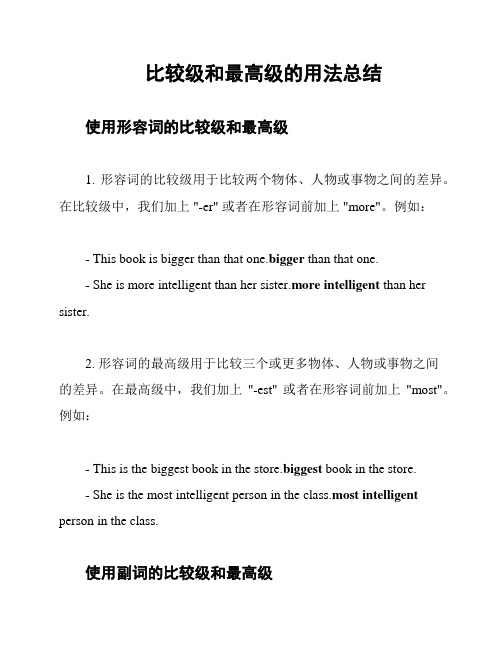
比较级和最高级的用法总结使用形容词的比较级和最高级1. 形容词的比较级用于比较两个物体、人物或事物之间的差异。
在比较级中,我们加上 "-er" 或者在形容词前加上 "more"。
例如:- This book is bigger than that one.bigger than that one.- She is more intelligent than her sister.more intelligent than her sister.2. 形容词的最高级用于比较三个或更多物体、人物或事物之间的差异。
在最高级中,我们加上"-est" 或者在形容词前加上"most"。
例如:- This is the biggest book in the store.biggest book in the store.- She is the most intelligent person in the class.most intelligent person in the class.使用副词的比较级和最高级1. 副词的比较级和最高级的构造方式与形容词相似。
一般在副词后面加上 "-er" 或者在副词前面加上 "more" 来表示比较级;加上"-est" 或者在副词前面加上 "most" 来表示最高级。
例如:- He runs faster than his friend.faster than his friend.- She speaks more fluently than her classmates.more fluently than her classmates.2. 部分副词的比较级和最高级有特殊形式。
例如:- good (好): better (比较级), best (最高级)better (比较级), best (最高级)- well (好地): better (比较级), best (最高级)better (比较级), best (最高级)- bad (坏): worse (比较级), worst (最高级)worse (比较级), worst (最高级)构造句子时的注意事项1. 当物体、人物或事物是两个之间进行比较时,使用比较级。
比较级和最高级的用法

比较级和最高级的用法比较级和最高级是英语中两种重要的形容词、副词变化形式。
它们是用来表示物品、人或者概念等在质量、数量、程度等方面的大小关系的。
掌握比较级和最高级有助于英语学习者在表达中更准确、自然地表达自己的意思。
一、比较级的用法一、表示两个人或者物之间的大小关系比较级用来表示两者之中一个具有更强烈的特点或者更多的特点。
通常来说,比较级由“+er”或者由“more+形容词或者副词原形”。
1. +er的比较级形式+er的形式是唯一的,适用于单音节、双音节以及一些多音节词的形容词和副词。
例如:- I am taller than my sister.- This dress is cheaper than that.- She runs faster than him.2. more+形容词/副词原形more的形式应用于多音节的形容词和副词,它是无限制的形式。
例如:- This book is more interesting than the one I read last week.- She speaks more confidently than her friends.- The boy is more mature than others in his class.二、使用比较级进行比较1. 更多 than使用比较级的一个重要方面是来比较两个人或事物之间的差异。
通常使用“更多than”的形式来进行比较,如:- My sister has more friends than I do.- He exercises more frequently than I do.- She has more experience than I do in this field.2. 不如 than另一方面,比较级也可以使用“不如than”的形式来表示一个人或者物不如另一个人或物,如:- She is not as tall as her brother.- This restaurant is not as crowded as the other one.- Tom is not as smart as his friends.3. The -er, the -er可以通过使用“the + comparative形式 + the comparative形式”的结构来表示相应的效果随特定条件的增加/减少而增加/减少,例如:- The harder you study, the better your grades will be.- The more you practice, the better you will become.- The more you eat, the fatter you will get.4. nearly/hardly/barely/moderately等程度副词比较级还可以与程度副词一起使用,表示一定的程度。
高中英语知识点归纳比较级和最高级的用法区别

高中英语知识点归纳比较级和最高级的用法区别高中英语知识点归纳:比较级和最高级的用法区别比较级和最高级是英语中用于比较两个或多个事物之间差异或相对程度的形式。
它们在句子中起到了重要的作用,用以表达不同事物的程度、大小和质量等方面的差异。
在使用比较级和最高级时,需要注意它们的用法和区别。
本文将对比较级和最高级的用法进行归纳和比较。
一、比较级的用法1. 形容词和副词的比较级形式比较级用于比较两个事物之间的差异,表达“更……”。
形容词和副词的比较级一般是在词尾加上“-er”,如“bigger”(更大的)、“faster”(更快的)。
需要注意的是,在单音节词和某些双音节词前面,要在形容词或副词前加上“more”形成比较级,如“more intelligent”(更聪明的)、“more quickly”(更迅速地)。
2. 比较级的用法比较级可以与“than”连用,表示两者相比。
例如,“Tom is taller than John”(汤姆比约翰更高)。
3. 表示“越来越”的用法在表示越来越“……”的意思时,可以使用“比较级 + and + 比较级”的形式,例如,“The weather is getting colder and colder”(天气越来越冷)。
4. 其他特殊用法在比较级的用法中,还存在一些特殊的形式,如“the + 比较级,the + 比较级”和“the + 比较级 of the two(三……)”。
例如,“The more you read, the more you learn”(你读得越多,学到的就越多)。
二、最高级的用法1. 形容词和副词的最高级形式最高级用于比较三个或三个以上的事物,表达“最……”。
形容词和副词的最高级一般在词尾加上“-est”,如“biggest”(最大的)、“fastest”(最快的)。
与比较级一样,对于单音节词和某些双音节词,要在形容词或副词前加上“the most”来形成最高级,如“the most intelligent”(最聪明的)、“the most quickly”(最迅速地)。
最高级和比较级的用法

最高级和比较级的用法比较级的用法:1.双方比较表示一方超过另一方时, 用“比较级+than”的结构表示.例如:There are more workers in this factory than in that factory.这个工厂的工人比那个工厂的多.The climate of Dalian is better than that of Shanghai.大连的气候比上海好.The atmosphere of the earth is much denser than that of the moon. 地球的大气比月球的要稠密的多.2.表示一方不及另一方时,用“less +原级+ than”的结构表示.例如:This room is less beautiful than that one.这个房间不如那个房间漂亮.They speak less fluently but more correctly than we(do).他们讲得不如我们流利,但比我们准确.5.表示一方超过另一方的程度或为二倍时,可在比较级前加表示程度的状语.如: even, a little ,still, much, far , yet ,by far, slightly, very much, no, any, rather, a great deal, a lot, lots, a bit等修饰.例如:He works even harder than before.他比以前更加努力工作.There is lots more sugar in the storeroom.储藏室有更多的糖.He was too tired to walk any further.他太累了,再也走不动了.Are you any better than before?你今天比以前好点了吗?That would be a great deal better.那样的话就好多了.The photographs of Mars taken by satellites are much clearer than those taken from the earth.从卫星上拍的照片比从地球上拍的清楚.注意:英语的比较级前如无even, still或yet等时,译成汉语时可用“较……”或“……一些”或不译出,一般不可用“更”.如:She is better than she was yesterday.她比昨天好些了.Please come earlier tomorrow.明天请早点来.注意:by far, far, much 通常用于强调最高级.by far用于比较级时,一般放在比较级的后面.如放在前面,应在二者中间加“the”.far and away, out and away, the very只能用于修饰最高级.如:Building this tunnel was by far the most challenging problem in the system.建筑这样一条隧道无疑是这个系统中最棘手的工程.This is much the best.这是最好的.It is far and away ( or out and away) the best.这是好的无以复加.This is the very best book that he ever wrote.这是他写过的书中最好的一本.8.表示主语随另一方的程度而变化时,用“the +比较级(主语+谓语), the +比较级(主语+谓语)”的结构.例如:The harder he works, the happier he feels.他越努力工作越感到幸福.The higher we went up the mountain, the colder it became. 越往山的高处爬越冷.The more they talked, the more encouraged they felt.他们越说越感到鼓舞.12.不与其它事物相比,表示本身程度的改变时, 用“比较级+比较级”的结构.例如:The weather is getting colder and colder.天气越来越冷.The girl becomes more and more beautiful.这个女孩长得越来越漂亮.The days become longer and longer.天变的越来越长.We are walking more and more slowly.我们走得越来越慢.6. 在inferior(劣于), superior(优于), junior(年幼的), senior(年长的), prior(前面的), posterior(后面的)等后面用to代替than.例如:He is superior to Mr. Wang in mathematics.在数学上他比王先生好.His work is inferior to mine.他的工作不如我的好.He is 2 years senior to me.他比我大两岁.The duty is prior to all others.这项任务比其他任务都重要.7.在比较从句中为了避免重复,我们通常用that (those),one (ones)代替前面出现的名词,that指物,one既可指人,也可指物.that可代替可数名词单数和不可数名词,而one只能代替可数名词.例如:The book on the table is more interesting than that on the desk.餐桌上的那本书比课桌上的那本书有趣.A box made of iron is stronger than one made of wood .铁箱子比木箱子结实.“ the + 形容词的比较级+ of ”例如:He is the taller of the two.他是两个人中较高的一个.She is the more beautiful of the two sisters.她是两姐妹中较美的一个.Of the two landscapes that you have shown me, this one is the more picturesque.你给我看的两处景色中,这一处更别致.8.表示倍数的比较级有如下几种句型:A. A is three (four,etc.)times the size (height,length,width,etc.)of B例如:The new building is four times the size(the height)of the old one.这座新楼是那座旧楼的四倍大(四倍高).(这座新楼比那座旧楼大三倍[高三倍])B. A is three (four, etc.)times as big (high, long, wide, etc.)as B.例如:Asia is four times as large as Europe亚洲是欧洲的四倍大.(亚洲比欧洲大三倍.)C. A is three(four, etc.)times bigger(higher, longer, wider, etc.)than B例如:Your school is three times bigger than ours.你们的学校比我们的学校大三倍.(你们的学校是我们学校的四倍大.)用times表示倍数,一般限于表示包括基数在内三倍或三倍以上的数.表示两倍可以用twice或double.四、最高级的用法1. 三者或三者以上相比,2. 表示最高程度时,3. 用“the + 最高级”的结构表示.这种句式一般常有表示比较范围的介词短语.例如:Zhang Hui is the tallest of the three.张辉是三个人中最高的.He works (the) hardest in his class.他是班级中最用功的学生.2. 最高级可被序数词以及much, by far, nearly, almost, by no means, not quite, not really, nothing like等词语所修饰.例如:This hat is by far/much/ nearly/ almost/not nearly/ by no means/ not quite/nothing like the biggest.这个帽子是最大的.How much is the most expensive computer ?那个价格最昂贵的计算机需要多少钱?3. 表示“最高程度”的形容词,如excellent, extreme, perfect等,没有最高级,也不能用比较级.4. 形容词最高级修饰作表语或介词宾语的名词、代词时被修饰的词往往省略.例如:He is the tallest (boy) in his class.他是班级中最高的男孩.5. 作状语的副词最高级前可以不加定冠词.例如:Of all the boys he came (the) earliest.在所有的男生中他来得最早.。
比较级和最高级用法知识点总结

比较级和最高级用法知识点总结在英语学习中,比较级和最高级是非常重要的语法知识点。
它们用于描述事物之间的程度差异,让我们能够更准确、生动地表达自己的想法和感受。
接下来,就让我们一起深入了解比较级和最高级的用法吧。
一、比较级的构成1、一般情况下,直接在形容词或副词后面加er。
例如:tall taller,fast faster。
2、以不发音的字母 e 结尾的形容词或副词,直接加 r。
例如:nice nicer,large larger。
3、重读闭音节结尾的形容词或副词,双写末尾的辅音字母,再加er。
例如:big bigger,hot hotter。
4、以“辅音字母+y”结尾的形容词或副词,把 y 变为 i,再加 er。
例如:heavy heavier,busy busier。
5、多音节词和部分双音节词,在前面加 more。
例如:beautiful more beautiful,carefully more carefully。
二、比较级的用法1、表示两者之间的比较A + be 动词+比较级+ than +B 例如:I'm taller than you(我比你高。
)A +实义动词+比较级+ than +B 例如:He runs faster than me (他跑得比我快。
)2、比较级+ and +比较级表示“越来越……” 例如:It's getting colder and colder(天气变得越来越冷。
)3、 The +比较级……,the +比较级…… 表示“越……,越……” 例如:The more you study, the smarter you'll be(你学习越多,就会越聪明。
)4、可以用 much、a little、a lot、even、far 等修饰比较级,加强程度。
例如:He is much taller than his brother(他比他弟弟高得多。
比较级最高级的用法
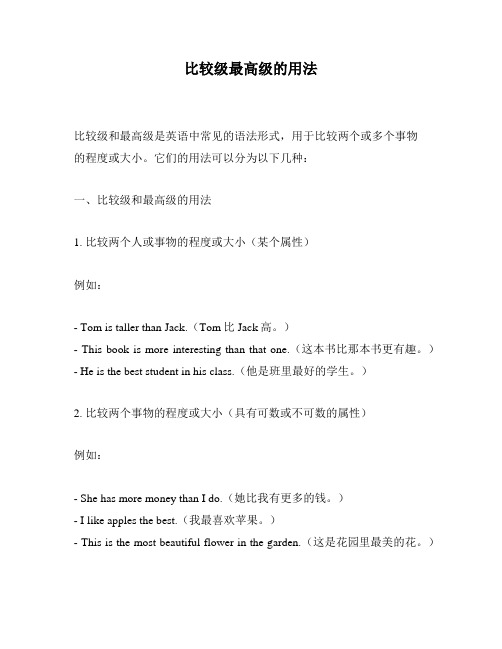
比较级最高级的用法比较级和最高级是英语中常见的语法形式,用于比较两个或多个事物的程度或大小。
它们的用法可以分为以下几种:一、比较级和最高级的用法1. 比较两个人或事物的程度或大小(某个属性)例如:- Tom is taller than Jack.(Tom比Jack高。
)- This book is more interesting than that one.(这本书比那本书更有趣。
)- He is the best student in his class.(他是班里最好的学生。
)2. 比较两个事物的程度或大小(具有可数或不可数的属性)例如:- She has more money than I do.(她比我有更多的钱。
)- I like apples the best.(我最喜欢苹果。
)- This is the most beautiful flower in the garden.(这是花园里最美的花。
)3. 表示两个或多个事物之间的区别例如:- He drives faster than I do.(他开车比我快。
)- This city is bigger than that one.(这个城市比那个城市大。
)- She is the most talented musician in the orchestra.(她是管弦乐团中最有才华的音乐家。
)4. 表示某个特定范围内的最高程度例如:- The tallest building in the world is in Dubai.(世界上最高的建筑在迪拜。
)- This is the best movie I have ever seen.(这是我看过的最好的电影。
)- The smartest students in the school are in this class.(学校中最聪明的学生在这个班级。
)5. 表示某个程度或数量的增加或减少例如:- The traffic is getting worse and worse.(交通越来越糟糕。
比较级与最高级用法
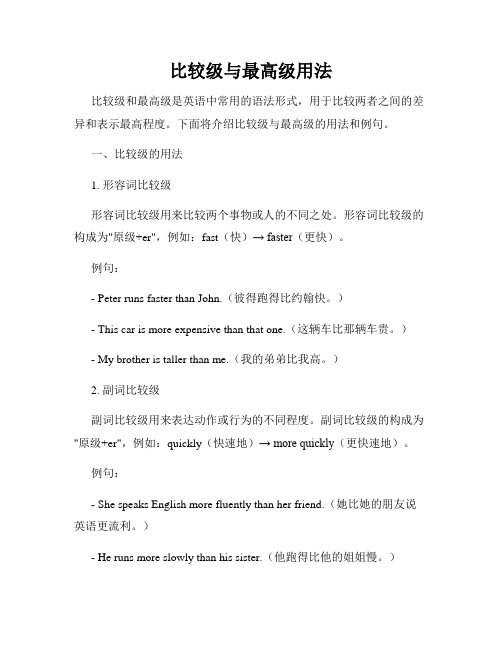
比较级与最高级用法比较级和最高级是英语中常用的语法形式,用于比较两者之间的差异和表示最高程度。
下面将介绍比较级与最高级的用法和例句。
一、比较级的用法1. 形容词比较级形容词比较级用来比较两个事物或人的不同之处。
形容词比较级的构成为"原级+er",例如:fast(快)→ faster(更快)。
例句:- Peter runs faster than John.(彼得跑得比约翰快。
)- This car is more expensive than that one.(这辆车比那辆车贵。
)- My brother is taller than me.(我的弟弟比我高。
)2. 副词比较级副词比较级用来表达动作或行为的不同程度。
副词比较级的构成为"原级+er",例如:quickly(快速地)→ more quickly(更快速地)。
例句:- She speaks English more fluently than her friend.(她比她的朋友说英语更流利。
)- He runs more slowly than his sister.(他跑得比他的姐姐慢。
)- They arrived earlier than expected.(他们比预计的时间早到。
)3. 不规则比较级有一些形容词和副词的比较级形式是不规则的,需要单独记忆。
例如:good(好)→ better(更好),bad(坏)→ worse(更糟)。
例句:- The weather today is better than yesterday.(今天的天气比昨天好。
)- Her performance in the exam was worse than expected.(她在考试中的表现比预期的要糟糕。
)二、最高级的用法1. 形容词最高级形容词最高级用来表达三个或三个以上事物或人之间的最高程度。
英语比较级和最高级的用法归纳
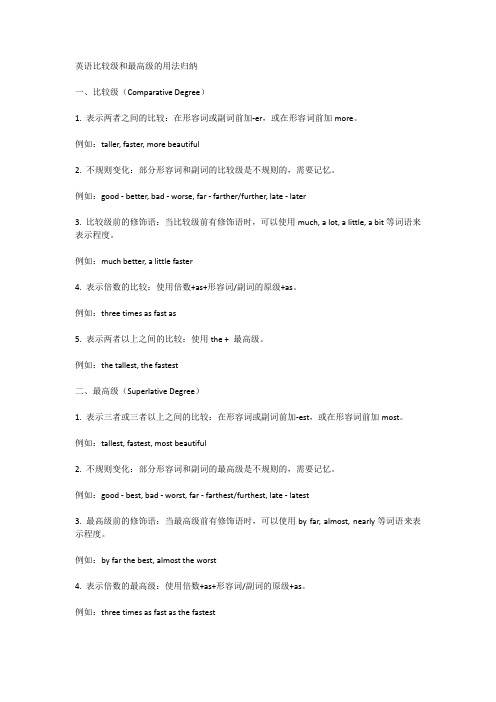
英语比较级和最高级的用法归纳一、比较级(Comparative Degree)1. 表示两者之间的比较:在形容词或副词前加-er,或在形容词前加more。
例如:taller, faster, more beautiful2. 不规则变化:部分形容词和副词的比较级是不规则的,需要记忆。
例如:good - better, bad - worse, far - farther/further, late - later3. 比较级前的修饰语:当比较级前有修饰语时,可以使用much, a lot, a little, a bit等词语来表示程度。
例如:much better, a little faster4. 表示倍数的比较:使用倍数+as+形容词/副词的原级+as。
例如:three times as fast as5. 表示两者以上之间的比较:使用the + 最高级。
例如:the tallest, the fastest二、最高级(Superlative Degree)1. 表示三者或三者以上之间的比较:在形容词或副词前加-est,或在形容词前加most。
例如:tallest, fastest, most beautiful2. 不规则变化:部分形容词和副词的最高级是不规则的,需要记忆。
例如:good - best, bad - worst, far - farthest/furthest, late - latest3. 最高级前的修饰语:当最高级前有修饰语时,可以使用by far, almost, nearly等词语来表示程度。
例如:by far the best, almost the worst4. 表示倍数的最高级:使用倍数+as+形容词/副词的原级+as。
例如:three times as fast as the fastest5. 表示所有事物中的最高程度:使用on earth, in the world等词语。
英语中比较级和最高级的用法
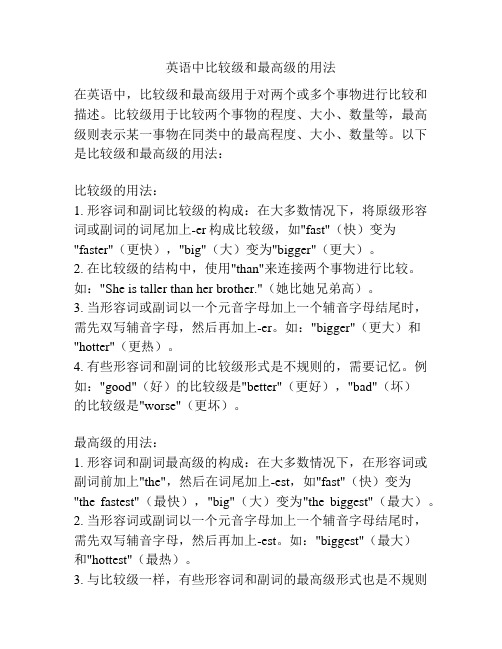
英语中比较级和最高级的用法在英语中,比较级和最高级用于对两个或多个事物进行比较和描述。
比较级用于比较两个事物的程度、大小、数量等,最高级则表示某一事物在同类中的最高程度、大小、数量等。
以下是比较级和最高级的用法:比较级的用法:1. 形容词和副词比较级的构成:在大多数情况下,将原级形容词或副词的词尾加上-er构成比较级,如"fast"(快)变为"faster"(更快),"big"(大)变为"bigger"(更大)。
2. 在比较级的结构中,使用"than"来连接两个事物进行比较。
如:"She is taller than her brother."(她比她兄弟高)。
3. 当形容词或副词以一个元音字母加上一个辅音字母结尾时,需先双写辅音字母,然后再加上-er。
如:"bigger"(更大)和"hotter"(更热)。
4. 有些形容词和副词的比较级形式是不规则的,需要记忆。
例如:"good"(好)的比较级是"better"(更好),"bad"(坏)的比较级是"worse"(更坏)。
最高级的用法:1. 形容词和副词最高级的构成:在大多数情况下,在形容词或副词前加上"the",然后在词尾加上-est,如"fast"(快)变为"the fastest"(最快),"big"(大)变为"the biggest"(最大)。
2. 当形容词或副词以一个元音字母加上一个辅音字母结尾时,需先双写辅音字母,然后再加上-est。
如:"biggest"(最大)和"hottest"(最热)。
比较级和最高级的语法
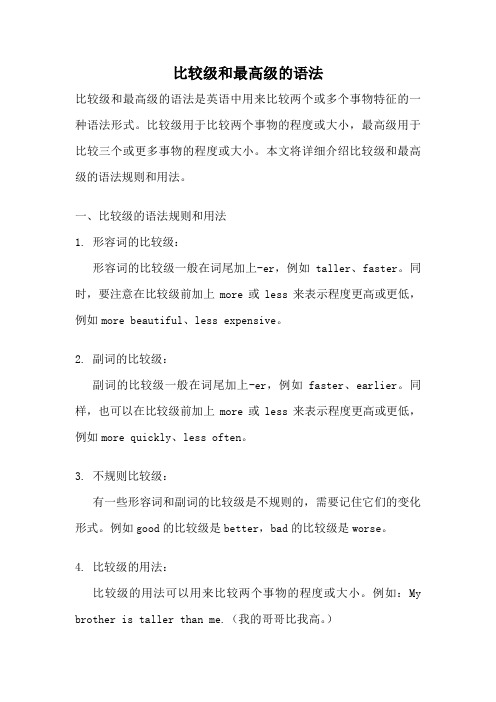
比较级和最高级的语法比较级和最高级的语法是英语中用来比较两个或多个事物特征的一种语法形式。
比较级用于比较两个事物的程度或大小,最高级用于比较三个或更多事物的程度或大小。
本文将详细介绍比较级和最高级的语法规则和用法。
一、比较级的语法规则和用法1. 形容词的比较级:形容词的比较级一般在词尾加上-er,例如taller、faster。
同时,要注意在比较级前加上more或less来表示程度更高或更低,例如more beautiful、less expensive。
2. 副词的比较级:副词的比较级一般在词尾加上-er,例如faster、earlier。
同样,也可以在比较级前加上more或less来表示程度更高或更低,例如more quickly、less often。
3. 不规则比较级:有一些形容词和副词的比较级是不规则的,需要记住它们的变化形式。
例如good的比较级是better,bad的比较级是worse。
4. 比较级的用法:比较级的用法可以用来比较两个事物的程度或大小。
例如:My brother is taller than me.(我的哥哥比我高。
)二、最高级的语法规则和用法1. 形容词的最高级:形容词的最高级一般在词尾加上-est,例如tallest、fastest。
同时,要注意在最高级前加上the来表示最高程度,例如the most beautiful、the least expensive。
2. 副词的最高级:副词的最高级一般在词尾加上-est,例如fastest、earliest。
同样,也可以在最高级前加上the来表示最高程度,例如the most quickly、the least often。
3. 不规则最高级:有一些形容词和副词的最高级是不规则的,需要记住它们的变化形式。
例如good的最高级是best,bad的最高级是worst。
4. 最高级的用法:最高级的用法可以用来比较三个或更多事物的程度或大小。
比较级和最高级的用法
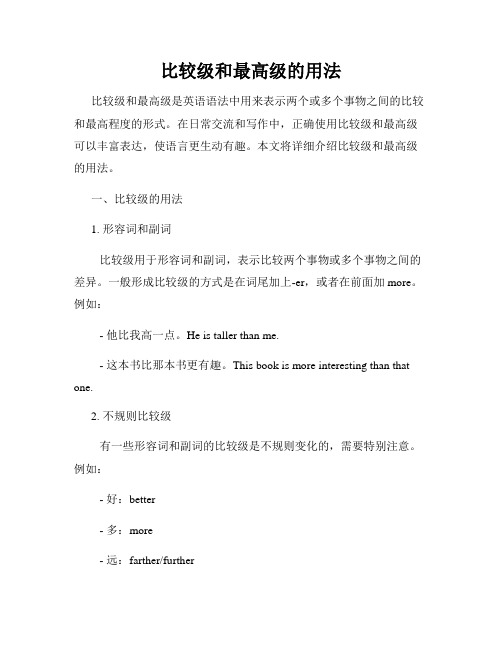
比较级和最高级的用法比较级和最高级是英语语法中用来表示两个或多个事物之间的比较和最高程度的形式。
在日常交流和写作中,正确使用比较级和最高级可以丰富表达,使语言更生动有趣。
本文将详细介绍比较级和最高级的用法。
一、比较级的用法1. 形容词和副词比较级用于形容词和副词,表示比较两个事物或多个事物之间的差异。
一般形成比较级的方式是在词尾加上-er,或者在前面加more。
例如:- 他比我高一点。
He is taller than me.- 这本书比那本书更有趣。
This book is more interesting than that one.2. 不规则比较级有一些形容词和副词的比较级是不规则变化的,需要特别注意。
例如:- 好:better- 多:more- 远:farther/further3. 比较级的结构比较级常与than连用,表示比较的对象。
例如:- 这本书比那本书更有趣。
This book is more interesting than that one.- 猫比狗更独立。
Cats are more independent than dogs.4. 与形容词修饰词连用比较级可以与形容词修饰词连用,表示程度上的比较。
例如:- 这个城市越来越拥挤。
This city is getting more and more crowded.- 天气越来越热了。
The weather is getting hotter and hotter.二、最高级的用法1. 形容词和副词最高级用于形容词和副词,表示三个或多个事物之间的比较程度。
一般形成最高级的方式是在词尾加上-est,或者在前面加most。
例如: - 他是我们班最高的男生。
He is the tallest boy in our class.- 这是我见过的最有趣的电影之一。
This is one of the most interesting movies I have ever seen.2. 不规则最高级有一些形容词和副词的最高级是不规则变化的,需要特别注意。
常见比较级和最高级的用法归纳
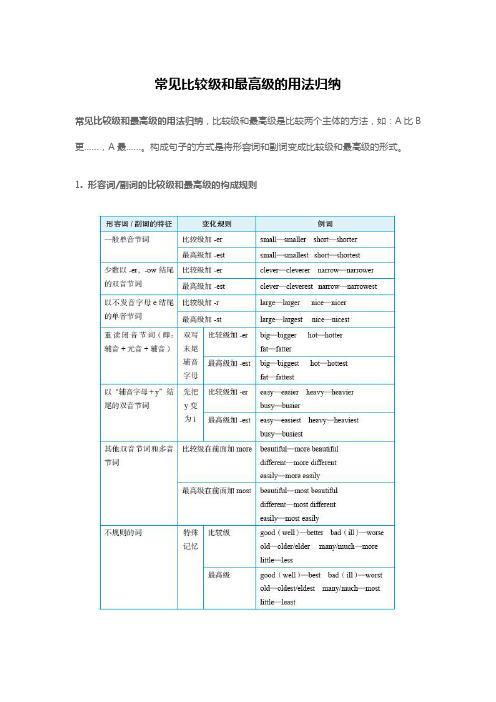
常见比较级和最高级的用法归纳常见比较级和最高级的用法归纳,比较级和最高级是比较两个主体的方法,如:A比B 更……,A最……。
构成句子的方式是将形容词和副词变成比较级和最高级的形式。
1. 形容词/副词的比较级和最高级的构成规则注意:形容词most前面如果没有the,就不表示最高级的含义,而是表示“非常”。
例句:It is a most important problem.语法:most前没有the,表示“非常”,该句还可以转化为:It is a very important problem.译文:它是一个非常重要的问题。
2. 形容词/副词比较级的用法(1)两者之间的比较,通常用连词than引导。
基本句型:“A+be/实义动词+形容词/副词比较级+than+B”,表示A比B更……。
例句:This train runs faster than that one.语法:faster是副词fast的比较级。
译文:这列火车比那列跑得更快。
(2)“less+原级(双音节和多音节)+than…”,表示“不如……”。
例句:Tim is less healthy than Tom.语法:less healthy than是“less+原级+than…”结构。
译文:提姆比汤姆体质要差。
(3)两者之间选择,其结构为:“which/who…+比较级,…or…?”例句:Which is bigger, the earth or the moon语法:bigger是big的比较级。
译文:地球和月亮哪个更大?(4)“比较级+and+比较级”,或“more and more+原级”表示“越来越……”。
例句:Shanghai is becoming more and more modern.语法:more and more modern为“more and more+原级”结构。
译文:上海正变得越来越现代化。
(5)“The+比较级,the+比较级”,表示“越……,越……”。
比较级与最高级的形式
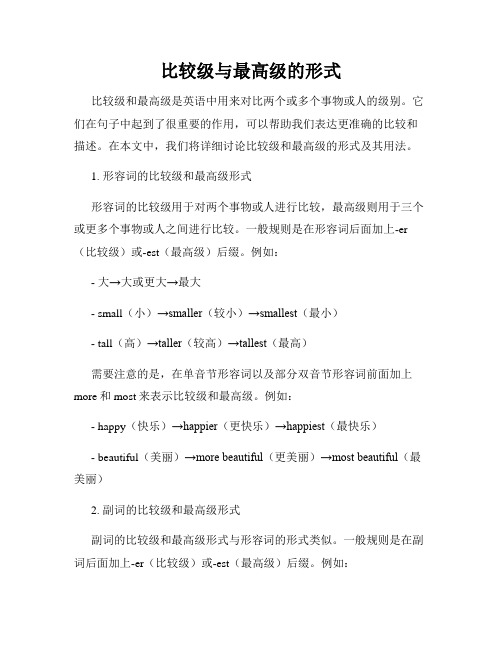
比较级与最高级的形式比较级和最高级是英语中用来对比两个或多个事物或人的级别。
它们在句子中起到了很重要的作用,可以帮助我们表达更准确的比较和描述。
在本文中,我们将详细讨论比较级和最高级的形式及其用法。
1. 形容词的比较级和最高级形式形容词的比较级用于对两个事物或人进行比较,最高级则用于三个或更多个事物或人之间进行比较。
一般规则是在形容词后面加上-er (比较级)或-est(最高级)后缀。
例如:- 大→大或更大→最大- small(小)→smaller(较小)→smallest(最小)- tall(高)→taller(较高)→tallest(最高)需要注意的是,在单音节形容词以及部分双音节形容词前面加上more和most来表示比较级和最高级。
例如:- happy(快乐)→happier(更快乐)→happiest(最快乐)- beautiful(美丽)→more beautiful(更美丽)→most beautiful(最美丽)2. 副词的比较级和最高级形式副词的比较级和最高级形式与形容词的形式类似。
一般规则是在副词后面加上-er(比较级)或-est(最高级)后缀。
例如:- fast(快速地)→faster(更快地)→fastest(最快地)- slowly(慢慢地)→more slowly(更慢地)→most slowly(最慢地)同样地,对于单音节副词以及部分双音节副词,需要使用more和most来表示比较级和最高级。
例如:- quickly(快速地)→more quickly(更快地)→most quickly(最快地)- easily(容易地)→more easily(更容易地)→most easily(最容易地)3. 不规则形式的比较级和最高级除了按照规则进行形容词和副词的比较级和最高级形式变化外,还存在一些特殊的不规则形式。
例如:- good(好)→better(更好)→best(最好)- bad(坏)→worse(更坏)→worst(最坏)- little(小)→less(更小)→least(最小)- much(多)→more(更多)→most(最多)这些不规则形式需要记住其特殊变化的词汇。
英语比较级和最高级的用法归纳
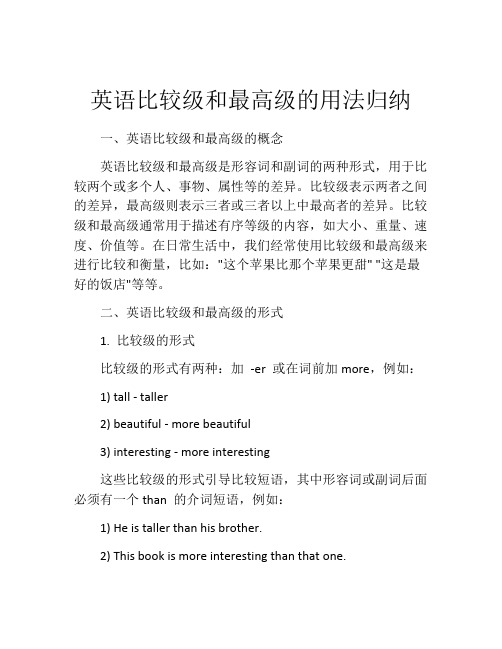
英语比较级和最高级的用法归纳一、英语比较级和最高级的概念英语比较级和最高级是形容词和副词的两种形式,用于比较两个或多个人、事物、属性等的差异。
比较级表示两者之间的差异,最高级则表示三者或三者以上中最高者的差异。
比较级和最高级通常用于描述有序等级的内容,如大小、重量、速度、价值等。
在日常生活中,我们经常使用比较级和最高级来进行比较和衡量,比如:"这个苹果比那个苹果更甜" "这是最好的饭店"等等。
二、英语比较级和最高级的形式1. 比较级的形式比较级的形式有两种:加-er 或在词前加more,例如:1) tall - taller2) beautiful - more beautiful3) interesting - more interesting这些比较级的形式引导比较短语,其中形容词或副词后面必须有一个than 的介词短语,例如:1) He is taller than his brother.2) This book is more interesting than that one.3) The weather is getting colder than yesterday.2. 最高级的形式最高级的形式与比较级的形式相似,但是最高级是加-est 或在词前加most,例如:1) tall - tallest2) beautiful - most beautiful3) interesting - most interesting这些最高级的形式引导最高级短语,其中形容词或副词后面必须有冠词"the" ,或指定的名词,例如:1) He is the tallest boy in his class.2) This is the most interesting book I have ever read.3) The weather is the coldest this winter.三、英语比较级和最高级的用法1. 表示相对高低英语比较级和最高级的最常见用途是表示相对高低。
比较级和最高级的用法

比较级和最高级的用法Comparatives and Superlatives比较级和最高级一、形容词比较级和最高级的规则一般在词尾加-er /ə/或-est/ist/原级XXXfastXXXlargebighoteasyearlyusinteresting比较级colderfasternicerlargerbiggerhotterXXXXXXmore usmore interesting最高级coldestfastestnicestlargestbiggesthottestXXXXXXmost usMost interesting以字母e末端的描述词,加-r或-st以重读闭音节末端且开端只要一个子音字母时,应先双写这个子音字母;再加-es或-est以“辅音字母+y”结尾的词,先改“y”为“i”,再加-er或-est在词前加more或most 别的不划定规矩的变革:真相Good/wellBad/illMany/muchlittlefar比力级betterworsemorelessXXX最高级XXXWorstMostLeastfarthest2、描述词比力级根本用法1、界说:两小我或物之间的比力。
透露表现“较……”或“更……一些”。
标记词:than(比).2、与than搭配的词语形式1)名词/代词He XXX.2)动名词/从句Skiing is XXX.3)状语/动词/描述词3、描述词/副词比力级前的润饰语1)much/a lot/ a bit/ a little/ slightlyShe is XXX today.2)any/ no/ even/ some/ stillDo you XXX today?XXX.3)数词My sister is ten years younger than me.4、比较级的特殊搭配1)“比力级+and+比力级”透露表现“愈来愈……”eg: XXX.他愈来愈胖了。
初中语法 比较级和最高级的用法
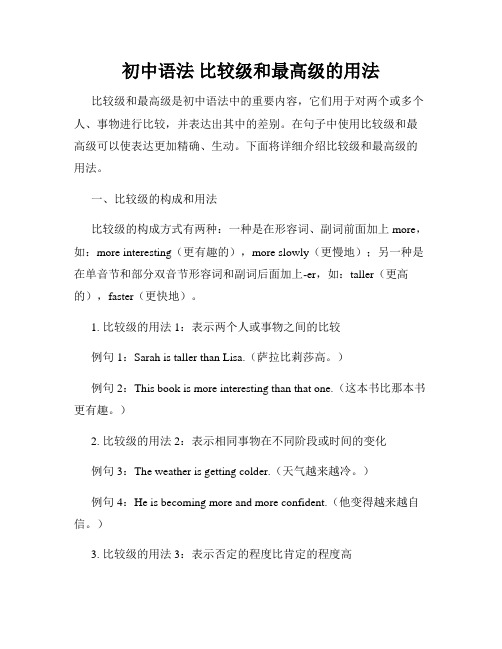
初中语法比较级和最高级的用法比较级和最高级是初中语法中的重要内容,它们用于对两个或多个人、事物进行比较,并表达出其中的差别。
在句子中使用比较级和最高级可以使表达更加精确、生动。
下面将详细介绍比较级和最高级的用法。
一、比较级的构成和用法比较级的构成方式有两种:一种是在形容词、副词前面加上more,如:more interesting(更有趣的),more slowly(更慢地);另一种是在单音节和部分双音节形容词和副词后面加上-er,如:taller(更高的),faster(更快地)。
1. 比较级的用法1:表示两个人或事物之间的比较例句1:Sarah is taller than Lisa.(萨拉比莉莎高。
)例句2:This book is more interesting than that one.(这本书比那本书更有趣。
)2. 比较级的用法2:表示相同事物在不同阶段或时间的变化例句3:The weather is getting colder.(天气越来越冷。
)例句4:He is becoming more and more confident.(他变得越来越自信。
)3. 比较级的用法3:表示否定的程度比肯定的程度高例句5:I don't think it's a good idea.(我认为这不是一个好主意。
)例句6:She didn't work as hard as her brother.(她没有像她哥哥那样用功。
)4. 比较级的用法4:表示主语和谓语之间的比较例句7:The more you practice, the better you will become.(你练习得越多,你就会变得越好。
)例句8:The harder you work, the more successful you will be.(你工作越努力,你就会越成功。
)二、最高级的构成和用法最高级的构成方式与比较级类似,一般是在形容词、副词前面加上most,如:most interesting(最有趣的),most slowly(最慢地);在单音节和部分双音节形容词和副词后面加上-est,如:tallest(最高的),fastest(最快地)。
比较级与最高级

比较级与最高级比较级和最高级是英语中用来比较两个或多个事物的形容词和副词的两种形式。
在句子中,它们能够帮助我们表达出比较的程度和最高的程度。
本文将详细介绍比较级和最高级的用法,以及一些常见的注意事项。
一、比较级的用法比较级用于比较两个事物的程度、大小、数量等。
一般来说,比较级的形成规则如下:1. 对于单音节和部分双音节形容词/副词,直接在词尾加上-er,例如:fast(快)- faster(更快)。
2. 对于以字母“e”结尾的单词,只需加-r,例如:large(大)- larger (更大)。
3. 对于以辅音字母+y结尾的单词,需将-y改为-i并再加-er,例如:happy(快乐)- happier(更快乐)。
4. 对于部分双音节和多音节形容词/副词,前面加上more,例如:beautiful(美丽)- more beautiful(更美丽)。
P.S. 有些形容词/副词是不规则的,比如good(好)- better(更好),bad(坏)- worse(更差)。
这些需要特别记忆。
比较级的使用方法如下:1. 在句子中,比较级之前一般会出现than,用来连接要比较的两个事物。
例如:She is taller than her sister.2. 当比较级修饰名词时,前面需要加上冠词the。
例如:He is the faster runner.二、最高级的用法最高级用于比较三个或三个以上的事物,表示最高程度。
一般来说,最高级的形成规则如下:1. 对于单音节和部分双音节形容词/副词,在词尾加上-est,例如:fast(快)- fastest(最快)。
2. 对于以字母“e”结尾的单词,只需加-st,例如:large(大)- largest(最大)。
3. 对于以辅音字母+y结尾的单词,需将-y改为-i并再加-est,例如:happy(快乐)- happiest(最快乐)。
4. 对于部分双音节和多音节形容词/副词,前面加上most,例如:beautiful(美丽)- most beautiful(最美丽)。
比较级和最高级的用法
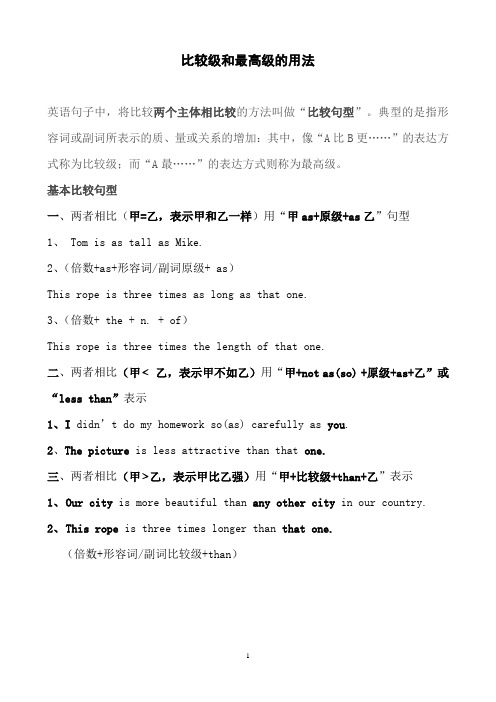
比较级和最高级的用法英语句子中,将比较两个主体相比较的方法叫做“比较句型”。
典型的是指形容词或副词所表示的质、量或关系的增加:其中,像“A比B更……”的表达方式称为比较级;而“A最……”的表达方式则称为最高级。
基本比较句型一、两者相比(甲=乙,表示甲和乙一样)用“甲as+原级+as乙”句型1、 Tom is as tall as Mike.2、(倍数+as+形容词/副词原级+ as)This rope is three times as long as that one.3、(倍数+ the + n. + of)This rope is three times the length of that one.二、两者相比(甲<乙,表示甲不如乙)用“甲+not as(so) +原级+as+乙”或“less than”表示1、I didn’t do my homework so(as) carefully as you.2、The picture is less attractive than that one.三、两者相比(甲>乙,表示甲比乙强)用“甲+比较级+than+乙”表示1、O ur city is more beautiful than any other city in our country.2、T his rope is three times longer than that one.(倍数+形容词/副词比较级+than)注意:①在含有连词than的比较级中,前后的比较对象必须是同一范畴,即同类事物之间的比较。
a)The population of Shanghai is larger than that of Beijing.b)It is easier to make a plan than to carry it out.c)His shirt is more expensive than mine(my shirt).(如果主语是物主代词+名词,那么后面要用名词性物主代词.)d)He is older than me.(than是介词,后面是人称代词时用宾格)e)Skiing is more exciting than skating. (比较对象可以是名词,短语,从句)②为了避免重复,在从句中常用one, that, those等词来代替前面提过的名词。
- 1、下载文档前请自行甄别文档内容的完整性,平台不提供额外的编辑、内容补充、找答案等附加服务。
- 2、"仅部分预览"的文档,不可在线预览部分如存在完整性等问题,可反馈申请退款(可完整预览的文档不适用该条件!)。
- 3、如文档侵犯您的权益,请联系客服反馈,我们会尽快为您处理(人工客服工作时间:9:00-18:30)。
4.heavy_______ _______ important careful easily _______ good far many 5.delicious_______ _____
best good→ better → worst bad → worse →
angrily angry→ ______
比较级:两人或两物之间进行比较。 (以A 、B指代两个比较对象)
A+动词+形容词/副词比较级+than+B
最高级:表示三者或三者以上比较,其中有 一个在某一方面超过其他几个时,用最高级。 A+动词 +the+形容词/副词最高级+of
/in……
一般情况
以e结尾的 以辅音字母+y结尾的
①形容词作定语一般放在被修饰 的名词之前。如 a new book, two big trees 等。 但如果修饰不定代词something, anything, everything, nothing等 时,要放在不定代词后面。
be look get keep turn feel become seem grow smell
Task
Write a short passage according to the form.
Name
Age
Height (身高)
Favourite Food
Kate Lucy Han Mei
11 12 13
1.50 metres Mooncakes 1.53 metres Dumplings 1.51 metres Noodles
more beatiful (beautiful). ___________
taller 5.He is the ________(tall) of the the two boys.
Find out the mistakes in the sentences below. 1. All of us felt happily happy at her birthday party. 2. I am more much older than Harry. 3. Her coat is newer than you. yours. that 4. The weather in Beijing is colder than in ∧ Xiamen. tallest 5. Sue is one of the tall girls in her  ̄ ̄ class.
以重读闭音节结尾,末尾 只有一个辅音字母的
多音节和部分双音节词
important long easy great safe wet strong happy careful thin good hot far fine late easily many
long _______ great strong 1.cheap______ ________safe fine late 2.nice ______ ______ wet thin hot ______
1.The six students put their closed ______(close)
hands in front of them. healthy 2.Do sports erery day to keep______(health). 3.It snowed heavily ______ (heavy) yesterday. heavy 4.The rain will be ______(heavy) in some places. sunny 5. It will be _____(sun) tomorrow. broken 6.Her pen was _______(break).
more →most many →
不规则变化, 要多加注意哦!
little → less → least
well→better →best worst badly→worse →
most much→more → far→ farther →farthest
。
1.Which do you likebetter ______(well),apples or oranges? older 2.Who is ______(old),Jim or Tom ? faster faster 3.Jack is running _____ and ______(fast) . more 4.Our country is becoming ______and
+ slow → ______ usually usual →______
real → really ______ careful→______ carefully
easy → easily ______
heavily heavy →______
happily happy→ ______
